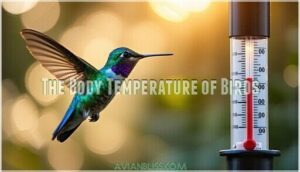This site is supported by our readers. We may earn a commission, at no cost to you, if you purchase through links.
 Yes, birds are warm blooded, which means they can maintain a steady body temperature regardless of the weather.
Yes, birds are warm blooded, which means they can maintain a steady body temperature regardless of the weather.
Their average body temperature hovers around 104-108°F, higher than most mammals, and a tiny part of their brain, the hypothalamus, acts like a thermostat, using energy from food to keep them warm when it’s cold or cool when it’s blazing outside.
Ever wonder why birds fluff their feathers on chilly days? It traps warm air, just like wearing a puffy jacket, which is a clever way for them to self-regulate.
This ability to multitask and self-regulate gives birds the freedom to survive in freezing mountains or scorching deserts, showcasing how nature certainly knows how to multitask.
Table Of Contents
- Key Takeaways
- Birds: Warm-Blooded Wonders
- The Body Temperature of Birds
- How Birds Stay Warm in Cold Conditions
- How Birds Stay Cool in Hot Conditions
- How Birds Prevent Their Feet From Freezing
- The Evolutionary History of Warm-Blooded Birds
- Interesting Facts About Birds and Their Warm-Blooded Nature
- Frequently Asked Questions (FAQs)
- Do birds have a hot body temperature?
- Are birds warm blooded or cold-blooded?
- Are birds hot or cold?
- Are birds cold blooded or endothermic?
- Why do birds eat cold blooded birds?
- Why are birds warm blooded?
- Are birds warm-blooded or cold-blooded?
- Why are birds warm-blooded if they are dinosaurs?
- Are birds the only warm-blooded animals that lay eggs?
- Is shark warm-blooded?
- Conclusion
Key Takeaways
- Birds are warm-blooded, keeping their body temperature between 104°F and 109°F, which helps them stay active in all climates.
- They use feather insulation, metabolic heat production, and behaviors like fluffing and roosting to regulate their temperature.
- Being warm-blooded gives birds the ability to live in extreme habitats, fuel flight, and stay resistant to fungal infections.
- Birds inherited their warm-blooded nature from dinosaur ancestors, gaining energy advantages that ensure survival year-round.
Birds: Warm-Blooded Wonders
You might be surprised to learn that birds are indeed warm-blooded creatures, just like you and other mammals.
Birds, the feathered wonders, are warm-blooded marvels, maintaining vibrant energy in both frosty winters and scorching summers.
These feathered animals maintain their body temperature between 104°F and 108°F through their own internal heat production, which allows them to stay active in both freezing winters and scorching summers.
What Does It Mean to Be Warm-Blooded?
Unlike reptiles that rely on sunshine to warm up, birds warm blooded nature means they’re endothermic – creating heat through metabolism instead of borrowing it from outside sources.
This Internal vs. External difference is huge.
Their bodies act like tiny furnaces, burning food to maintain Stable Body Temp around 106-109°F.
Thermoregulation Basics involve constant Metabolic Heat production, giving birds incredible temperature regulation control regardless of weather conditions.
Benefits of Being Warm-Blooded
Being warm blooded gives birds incredible physiological advantages that cold-blooded animals can’t match.
Their endothermic nature creates an active metabolism that powers flight and enables efficient foraging in any weather.
This internal heating system offers remarkable survival benefits:
- Diverse Habitat – You’ll find birds thriving from Arctic tundra to scorching deserts
- Flight Advantage – Constant energy fuels their demanding aerial lifestyle
- Fungal Resistance – High body temperatures naturally fight off infections
- Year-Round Activity – They stay alert and mobile regardless of season
How Do Birds Regulate Their Body Temperature?
When you observe birds thriving in various climates, you’re witnessing sophisticated thermoregulation mechanisms in action.
Their bird physiology operates like a built-in climate control system through these key processes:
- Metabolic heat production burns fuel to generate warmth internally
- Feather insulation traps air pockets for temperature control
- Physiological changes adjust blood flow to regulate heat distribution
- Behavioral adaptations include panting and seeking appropriate shelter
The Body Temperature of Birds
You might think birds run at about the same temperature as humans, but you’d be wrong.
Birds actually maintain body temperatures between 106°F and 109°F, which is substantially hotter than your own 98.6°F baseline.
Normal Body Temperature Range
Birds run much hotter than you might expect – their avian body temperature typically ranges from 106 to 109 degrees Fahrenheit, substantially higher than your 98.6°F.
This bird endothermy creates an impressive Avian Thermostat that keeps them active in diverse conditions.
Temperature Variation exists across species: tiny hummingbirds maintain temperatures near the upper limit, while larger birds like eagles run slightly cooler.
Your bird thermoregulation system faces Thermoregulation Limits – going too high risks organ damage, while dropping too low affects flight performance.
Environmental Impact influences these ranges, but warmblooded birds maintain remarkably stable internal temperatures regardless of outside conditions.
To conserve energy, some species enter nocturnal torpor states.
How Metabolic Rate Affects Body Temperature
Like a high-performance engine, your bird’s metabolic rate directly controls its avian body temperature through constant energy consumption. Smaller birds burn fuel faster, maintaining higher temperatures than larger species through rapid metabolic heat production.
Bird metabolism works like a built-in furnace, converting food into warmth through thermogenesis while balancing heat loss mechanisms. You’ll notice metabolic rate variations between species – hummingbirds run much hotter than eagles.
This efficient bird thermoregulation system operates through four key processes:
- Cellular respiration transforms nutrients into heat energy
- Muscle contractions generate additional warmth during activity
- Digestive processes create metabolic heat as fuel breaks down
- Shivering triggers rapid temperature increases when needed.
This body temperature control system never stops working.
The Role of The Hypothalamus in Temperature Regulation
Deep inside every bird’s brain sits a control center called the hypothalamus.
This remarkable structure works like your home’s thermostat, monitoring body temperature constantly through specialized sensors.
When hypothalamus function detects cooling, it sends metabolic signals to boost heat production.
If overheating occurs, it triggers cooling responses like panting.
This precise thermostat control guarantees perfect temperature regulation in all conditions.
How Birds Stay Warm in Cold Conditions
You’ve probably watched birds hopping around in the snow and wondered how they don’t freeze their tiny feet off.
Birds use smart tricks like fluffing their feathers, huddling together, and eating high-energy foods to keep their bodies warm when temperatures drop.
Migration Strategies
Millions of birds escape winter’s grip through seasonal migration, one of nature’s most impressive survival strategies.
You’ll witness incredible navigation techniques as they use magnetic fields, star patterns, and landmarks to find warmer climates.
Their flight physiology adapts perfectly for these epic journeys, while climate change impact increasingly affects traditional bird migration patterns.
- Timing matters: Birds read seasonal cues like daylight changes and temperature drops
- Distance varies: Some travel short hops while others cross continents
- Energy planning: Fueling migration requires careful preparation and fat storage
Food for Energy
Fueling their metabolisms becomes critical for winter survival.
Birds actively seek High-Calorie Foods like Energy-Rich Seeds and nuts, which burn like internal furnaces.
They’ll consume over 35% of their body weight daily to maintain thermoregulation. Fat Reserves build up before cold seasons, providing essential energy storage.
Winter Feeding stations stocked with suet help meet their Nutritional Needs when natural food sources disappear completely.
Supplementing with high-fat suet provides quick energy boosts.
Huddling and Fluffing Feathers
Birds master winter survival through smart teamwork and natural engineering.
When temperatures drop, they huddle together like friends around a campfire, cutting heat loss by half. Their feather structure works like nature’s down jacket – fluffing creates air pockets that boost insulation efficiency and maintain stable body temperature through superior thermoregulation.
Birds’ natural insulation is similar to a feather down jacket’s design, trapping warmth efficiently.
- Huddling benefits include shared warmth and reduced energy costs
- Fluffing benefits create maximum feather insulation against cold
- Air pocket formation traps heat close to skin surface
- Feathers act as adjustable thermal barriers for temperature control
Tucking in and Roosting
When feather fluffing isn’t enough, birds turn to nighttime strategies that showcase remarkable behavioral thermoregulation.
Roosting behavior involves tucking legs and bills deep into feathers while seeking protected shelter selection spots like tree cavities or dense brush.
This bird behavior creates shared warmth when multiple birds gather together.
Smart roosting and huddling with effective feather insulation can reduce heat loss by fifty percent during freezing nights.
How Birds Stay Cool in Hot Conditions
You’ve learned how birds keep warm, but what happens when temperatures soar and they need to cool down instead?
Birds use several smart methods to beat the heat, from panting like dogs to taking cooling baths and finding shade.
Panting and Air Sacs
Hot weather presents a real challenge for our feathered friends, but they’ve got some clever tricks up their sleeves.
Panting works differently in birds than mammals. They open their beaks wide and flutter their throat muscles rapidly, creating airflow dynamics that promote heat dissipation through evaporation. Their unique air sacs connect to lungs, making this panting mechanism incredibly efficient for thermoregulation.
Here’s how this amazing respiratory efficiency helps with temperature regulation:
- Rapid throat vibrations release excess body heat
- Air sac function circulates cool air throughout their body
- Moisture evaporation from mouth and throat creates cooling
- Specialized breathing patterns maximize heat loss without exhaustion
Bathing and Seeking Shade
When temperatures climb, you’ll see birds plunge into shallow puddles for bathing benefits that provide instant relief.
This behavioral thermoregulation uses evaporative cooling to lower their body temperature effectively.
Shade seeking becomes equally important as birds retreat under trees, avoiding dangerous sun exposure.
These hot weather adaptations and cooling behaviors help maintain proper bird temperature regulation without energy-draining panting.
Providing a refreshing bird bath can also help birds stay cool.
Specialized Heat Exchange Systems
Like tiny air conditioners, heat exchange systems help you understand how birds beat the heat.
Countercurrent exchange works through specialized vascular adaptations where blood vessels transfer warmth efficiently.
Air sacs circulate cool air throughout their bodies while feather insulation can be adjusted for ideal heat loss mechanisms.
These circulatory adaptations and temperature regulation systems let birds thrive in scorching conditions without breaking a sweat.
How Birds Prevent Their Feet From Freezing
You’ve probably watched ducks walk on ice and wondered how their bare feet don’t freeze solid in winter weather.
Birds have special blood vessels in their legs that work like a heat exchanger to keep warm blood flowing to their feet even in freezing temperatures.
Vascular System Adaptations
Birds possess incredible vascular adaptations that prevent frozen feet through sophisticated blood flow control.
Their specialized vein structure and artery function create efficient heat exchange systems that maintain essential foot temperature even on ice.
Here’s how these circulatory adaptations work:
- Countercurrent exchange warms returning blood before reaching the heart
- Specialized vessels minimize bird body heat loss
- Advanced temperature regulation keeps feet functional in freezing conditions
These adaptations are vital for optimal avian circulation, allowing birds to thrive in diverse environments.
Heat Exchange Mechanisms
When arctic winds blow, birds rely on sophisticated counter-current heat exchange systems to survive.
This biological marvel works like a radiator in reverse – warm arterial blood flowing to feet heats cooler venous blood returning to the body.
| Heat Exchange Component | Function |
|---|---|
| Arterial Blood Flow | Carries warm blood to extremities |
| Venous Return | Returns cooled blood to core |
| Vascular Networks | Creates efficient heat transfer |
| Blood Flow Regulation | Maintains ideal body temperature |
This thermoregulation keeps feet functional without freezing core temperature.
Birds also employ behavioral adaptations such as roosting to conserve warmth.
Ice Resistance and Cold Adaptations
When you watch birds standing on frozen lakes, you’re seeing nature’s most impressive cold weather adaptations in action.
Their specialized vascular adaptations prevent ice damage through these key survival strategies:
- Counter-current heat exchange warms returning blood while cooling outgoing flow
- Reduced muscle tissue in feet minimizes frostbite risk
- Specialized scales provide natural insulation barriers
- Behavioral strategies like tucking feet conserve heat
- Arctic species develop feathered feet for extra protection
These thermoregulation strategies guarantee bird survival.
The Evolutionary History of Warm-Blooded Birds
You’ll discover that birds didn’t just randomly develop their warm-blooded nature – they inherited it from their dinosaur ancestors over 150 million years ago.
This evolutionary advantage helped early birds survive in diverse climates and may have even protected them from deadly fungal infections that plagued cold-blooded animals, giving them a significant advantage.
Fossil Evidence and Early Bird-Like Animals
Scientists have uncovered remarkable fossilized remains that tell the story of bird origins.
Early theropods like Archaeopteryx bridge the gap between dinosaurs and modern birds, showing clear dinosaur ancestry while displaying primitive feather evolution.
These fossil discoveries reveal that early birdlike animals were already warmblooded:
- Feathered fossils prove heat regulation existed 150 million years ago
- Bone structure shows high metabolic rates in ancient species
- Theropod dinosaurs passed endothermic traits to their bird descendants
Evolution clearly favored warmblooded creatures.
The Role of Fungal Infections in Evolution
Defense against deadly threats shaped bird evolution in unexpected ways.
You’ll find that Fungal Resistance became a vital Endotherm Advantage when early birds developed warm-bloodedness.
Fungal Pathogens can’t survive the high body temperatures that birds maintain, giving them superior Pathogen Defense.
This evolutionary breakthrough protected avian biology from Fungal Infections that plague cold-blooded animals, making warm-bloodedness a game-changing survival strategy for birds throughout their evolutionary history.
Benefits of Being Warm-Blooded in Evolution
When birds evolved warm-blooded capabilities, they gained access to nature’s ultimate survival toolkit.
This thermoregulation breakthrough provided Metabolic Advantages that cold-blooded creatures couldn’t match – constant energy for flight and foraging regardless of weather conditions.
You’ll find warmblooded animals dominating diverse habitats because evolution granted them Habitat Expansion abilities.
Bird evolution shows how Flight Efficiency improved dramatically once internal temperature control developed.
Beyond movement benefits, warm-bloodedness offered Fungal Infection Defense – their high body temperatures create hostile environments for most fungi.
These Ancestral Origins explain why modern birds thrive everywhere from Arctic tundra to tropical rainforests, maintaining survival advantages their dinosaur ancestors passed down.
The development of feathers, as explained by bird adaptation features, also contributed to avian success.
Interesting Facts About Birds and Their Warm-Blooded Nature
You’ll discover that birds share their warm-blooded nature with an unexpected group of ancestors – the mighty dinosaurs that ruled Earth millions of years ago.
These fascinating creatures maintain body temperatures that run hotter than your own, reaching up to 109°F while using clever tricks like blood circulation systems that prevent their feet from turning into ice cubes, which is a testament to their unique warm-blooded nature.
Dinosaur Ancestry and Endothermic Nature
You might be surprised to learn that birds inherited their warm-blooded superpowers from theropod dinosaurs.
Birds inherited their warm-blooded superpowers from ancient theropod dinosaurs, unlocking the ability to thrive in extreme climates.
Fossil evidence shows these ancient predators, including the Maniraptora group, developed warmbloodedness around 150 million years ago.
Feather evolution originally helped dinosaurs regulate temperature, not fly.
This metabolic origins breakthrough may have protected them from fungal infections.
The evolution of birds directly traces back to these heat-generating giants, revolutionizing survival strategies forever.
Cold-Blooded Animals and Their Differences
Two distinct survival paths separate warm blooded birds from coldblooded creatures.
Ectotherms vs. Endotherms showcase nature’s creativity – reptiles master external temperature regulation through basking and shade-seeking, while amphibians develop unique environmental adaptations.
Metabolic differences reveal fascinating trade-offs: coldblooded animals need less food but become sluggish in cold weather.
This environmental impact limits their activity, unlike endothermic birds who stay active year-round through internal thermoregulation.
Unique Adaptations for Warm-Blooded Birds
Warm-blooded birds possess extraordinary adaptations that put them ahead of the game.
You’ll find their feather insulation works like nature’s down jacket, trapping air to maintain body temperature.
Their blood vessel systems act as internal heating networks, while specialized metabolic rates fuel constant heat production.
Behavioral strategies help them tackle temperature extremes – from fluffing feathers in winter to seeking shade in summer.
These survival strategies and thermoregulation strategies make bird adaptations truly remarkable unique adaptations.
Frequently Asked Questions (FAQs)
Do birds have a hot body temperature?
A bird’s body temperature stays between 106°F and 109°F, hotter than yours on a feverish day.
This helps them thrive in the wild, whether they’re soaring in icy skies or strutting in desert heat.
Are birds warm blooded or cold-blooded?
Birds are warm-blooded creatures, meaning they generate their own heat to stay cozy.
With body temperatures around 104–109°F, they can thrive in freezing tundras or scorching deserts, using feathers and behaviors to regulate heat effectively, which is a key aspect of being warm-blooded.
Are birds hot or cold?
You know what they say, “warm hands, warm heart.”
Birds fall more into the "warm" category.
They’re warm-blooded creatures, keeping their bodies a toasty 104-107°F, no matter how chilly or steamy the weather gets.
Are birds cold blooded or endothermic?
They’re endothermic, meaning they generate their own heat to stay warm.
Their high metabolism helps maintain body temperatures between 106-109°F.
You could say they pack their own furnace, no matter the weather.
Why do birds eat cold blooded birds?
Birds eating cold-blooded animals is all about survival.
Cold-blooded creatures, like insects or reptiles, are energy-packed meals.
Birds need the nutrients to fuel their high metabolism and regulate their warm blood in tough environments, which is crucial for their metabolism.
Why are birds warm blooded?
They’re warm-blooded to stay active in any weather, producing their own heat like a built-in furnace.
This helps them survive in extreme habitats, fuels flight, and keeps energy flowing even when it’s freezing outside.
Are birds warm-blooded or cold-blooded?
Imagine carrying a tiny furnace inside you—birds do!
They’re warm-blooded, meaning they produce their own heat.
This helps them stay active in icy winters or scorching heat, unlike cold-blooded animals that depend on external warmth.
Why are birds warm-blooded if they are dinosaurs?
Birds are warm-blooded because they inherited this trait from dinosaur ancestors like theropods.
It helps them survive in diverse environments, stay active in cold weather, and maintain energy for flying, hunting, or escaping predators.
Are birds the only warm-blooded animals that lay eggs?
No, they’re not.
Most reptiles, like turtles and crocodiles, also lay eggs.
But birds are unique because they’re warm-blooded and can incubate their eggs with body heat, ensuring a stable environment for development.
Is shark warm-blooded?
Not all sharks are warm-blooded, but some, like great whites and makos, can heat parts of their bodies.
This helps them swim fast and survive colder waters—think of it like nature’s heating system!
Conclusion
A bird’s body temperature, averaging 104-108°F, is an impressive example of its warm-blooded design.
This ability to regulate heat enables survival in extreme climates, from snowy peaks to hot deserts.
Their hypothalamus acts like a thermostat, while behaviors like fluffing feathers, panting, and roosting enhance their adaptability.
So, are birds warm blooded? Absolutely, and this unique trait allows them to thrive in challenging environments, proving nature’s brilliance in creating self-regulating, energy-efficient creatures.














